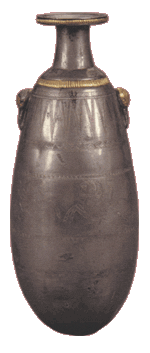 |
SILVER
AND GOLD
Height 156 cm. ; diameter at rim 3.3 cm. ; diameter of body 6.2
cm. ; weight 148.95 gr.
USAK MUSEUM
The body of the alabastron is divided into alternately decorated
and undecorated zones by six ornamental bands. The uppermost band
contains evenly spaced circles with central dot, bordered below
by a narrower band of hatching. The second band contains a zigzag
with hatching at top and bottom, in opposed directions, framed
between two narrow plain bands. The third and fourth bands contain
a row of hatched triangles between two narrow plain bands; the
hatched triangles of the third band point up, those of the fourth
band are suspended from the upper border. In the fifth band is
a simple meander-like pattern, with horizontal hatching on the
vertical bar and vertical hatching on the horizontal bar, the
pattern framed by two narrow dotted bands. The sixth band contains
a row of dots framed by two narrow plain bands. The first and
fifth registers are decorated with geometric designs, and in the
third register is a frieze of animals and horsemen. In the uppermost
register is a series of pendant triangles with hatched borders,
and in the fifth zone is a row of ten bordered rays, point up,
with hatching alternately in the centres and the borders. The
figural frieze of the third register features two mounted figures,
and two pairs of lions, one of each pair attacking a bull, the
other a goat. The mounted figures are confronted, the horses rearing
up on their hind legs. The lions attacking the bulls have head
shown in profile, with spotted face, eye shown as a lozenge with
overlapping comers, mane indicated by groups of short vertical
lines, and body covered with more widely spaced short bands. The
lions attacking the goats are shown frontal, with cross-hatched
mane and circular spots on body. The bulls have right foreleg
bent back, left bent forward, spotted body
and several closely spaced wrinkle lines around the neck ; along
the ridge of the back is a hatched spine, like that of a boar.
The goats have short curling hatched tail and groups of hairs
on body both forelegs are bent back and head held upside down,
with horns marked by two pairs of short lines. At opposite sides
of the vessel in the uppermost zone are two duck-head lugs with
engraved plumage and facial markings, covered, apart from the
beak, with gold foil which picks up the details worked on the
head; some of the foil has broken away. Just below the shoulder
the alabastron is encircled by a vertically ribbed gold band,
and there is a similarly decorated narrower band encircling the
edge of the rim. The alabastron was probably made in more than
one part, the joins masked by the gold bands. Inside the neck
is a separate reinforcing cylinder, as with no. 75, and the alabastron
was found complete with its plain flat-topped stopper. Around
the neck were two wires, joined to a circular tab at one side
from which projected two vertically aligned wire rings, presumably
for hanging the vessel.
The ornamental bands and the duck-head lugs suggest that this
alabastron was a product of the same tradition, possibly the same
workshop (although perhaps of an earlier date), that produced
the examples from Ikiztepe (nos. 75-78). No. 78 also features
lions attacking bulls in one of its figural friezes, although
the animals are not executed in the same way.
|









